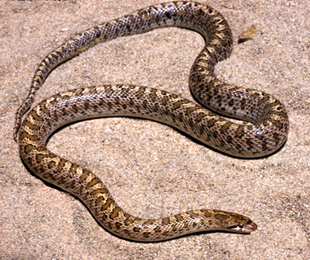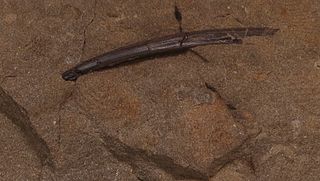
Caenorhabditis elegans is a free-living transparent nematode about 1 mm in length that lives in temperate soil environments. It is the type species of its genus. The name is a blend of the Greek caeno- (recent), rhabditis (rod-like) and Latin elegans (elegant). In 1900, Maupas initially named it Rhabditides elegans. Osche placed it in the subgenus Caenorhabditis in 1952, and in 1955, Dougherty raised Caenorhabditis to the status of genus.

The red-eared slider or red-eared terrapin is a subspecies of the pond slider, a semiaquatic turtle belonging to the family Emydidae. It is the most popular pet turtle in the United States, is also popular as a pet across the rest of the world, and is the most invasive turtle. It is the most commonly traded turtle in the world.

Zinnia is a genus of plants of the tribe Heliantheae within the family Asteraceae. They are native to scrub and dry grassland in an area stretching from the Southwestern United States to South America, with a centre of diversity in Mexico. Members of the genus are notable for their solitary long-stemmed 12 petal flowers that come in a variety of bright colors. The genus name honors German master botanist Johann Gottfried Zinn (1727–59).

The king rail is a waterbird, the largest North American rail.

Arizona elegans is a species of medium-sized colubrid snake commonly referred to as the glossy snake or the faded snake, which is endemic to the southwestern United States and Mexico. It has several subspecies. Some have recommended that A. elegans occidentalis be granted full species status.

Gypsophila elegans, the annual baby's-breath or showy baby's-breath, is an ornamental plant native to Asia and Europe.

The white-winged apalis is a species of bird in the family Cisticolidae. It is found in Kenya, Malawi, Mozambique, and Tanzania. Its natural habitats are subtropical or tropical moist lowland forest and subtropical or tropical moist montane forest. It is threatened by habitat loss.

The Wyoming ground squirrel is a species of rodent in the family Sciuridae. It is endemic to the Northwestern United States.

The western terrestrial garter snake is a western North American species of colubrid snake. At least five subspecies are recognized.

Calochortus elegans is a species of flowering plant in the lily family known by the common name elegant Mariposa lily, cat's ear, elegant cat's ears or star tulip. It is native to the western United States from northern California to Montana.

Zinnia elegans known as youth-and-age, common zinnia or elegant zinnia, is an annual flowering plant in the family Asteraceae. It is native to Mexico but grown as an ornamental in many places and naturalised in several places, including scattered locations in South and Central America, the West Indies, the United States, Australia, and Italy.
Amata chariessa is a moth of the subfamily Arctiinae. It was described by Karl Jordan in 1936. It is found in Zambia.
C. elegans most commonly refers to the model round worm Caenorhabditis elegans. It may also refer to any of the species below. They are listed, first in taxonomic order and, second, alphabetically.
Chariessa is a genus of checkered beetles in the family Cleridae. Chariessa beetles are carnivorous and often associated with trees of the genus Quercus, likely due to a preference for lignicolous insects that live in oaks.

Cosmacanthus is an extinct genus of placoderms in the extinct family Groenlandaspididae that lived during the Late Devonian in Ireland, the UK, Russia and North America. It was named by Louis Agassiz in 1845.
Mangelia chariessa is an extinct species of sea snail, a marine gastropod mollusk in the family Mangeliidae.

Chariessa pilosa is a species of checkered beetle in the family Cleridae. It is found in Europe and Northern Asia and North America.
Chariessa dichroa is a species of checkered beetle, belonging to the genus Chariessa. It is found in North America, most commonly on the West Coast. C. dichroa is distinguished from similar members of its genus by its black legs. Like other Chariessa beetles, it is carnivorous.

Mariannaea elegans an anamorphic fungus. It is mainly found on rotting wood and soil. M. elegans is not pathogenic to humans, animals, or plants.

Chariessa catalina is a recently described species of North American checkered beetle. Chariessa catalina can be distinguished from Chariessa elegans by an elytra that is closer to blue than black, and a forebody that is closer to crimson than C. elegans' diluted-blood red. C. catalina and C. elegans share a range in the southwestern corner of the continent but the range of C. elegans extends north toward the U.S.-Canadian border. This species seems to be most often encountered in March. The type specimen was collected in the Catalina Mountains of Arizona in 1969.















